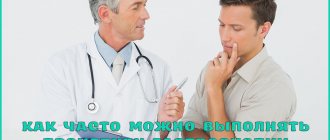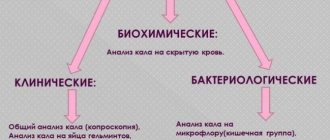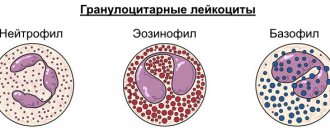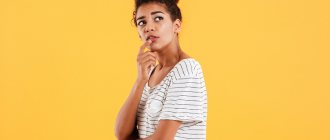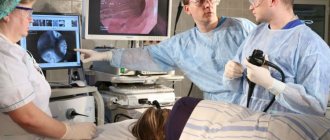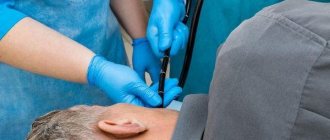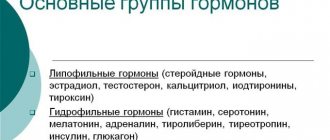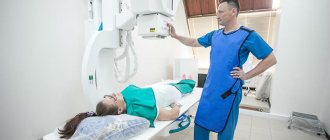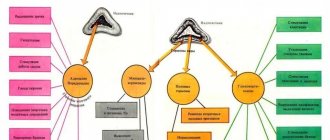Fibroesophagogastroduodenoscopy (FEGDS, EGDS) is an endoscopic method for examining the mucous membrane of the esophagus, stomach and duodenal bulb (DU) by examining them with a flexible optical probe. It is worth noting that the examination is in most cases performed with local anesthesia with Lidocaine. However, gastroscopy is often performed under anesthesia, that is, in deep sleep, which avoids significant discomfort.
Scheme of gastroscopy
With the modern capabilities of our medicine, FGDS is the most common examination, since diseases of the stomach and intestines, according to medical statistics, occupy first place in the world among other pathologies. Doctors perform about 300 thousand endoscopic examinations every day. If we compare FGDS with radiography of the gastrointestinal tract (gastrointestinal tract), then the latter is less informative for diagnosing diseases.
Anesthesia during gastroscopy is relevant not only in adult patients, but also in pediatric practice. FGDS is performed on children from birth for various indications:
- frequent heavy regurgitation;
- vomiting blood;
- malformations of the stomach;
- acute obstruction;
- foreign body.
Modern gastroscopes of the 3rd and 4th generations can make a high-quality examination and examine up to 87% of the mucous membrane of the stomach and esophagus.
General information
According to statistics, more than 80% of modern people suffer from various diseases of the gastrointestinal tract. In order to promptly diagnose pathologies (including identifying neoplasms), gastroscopy is prescribed. The examination is carried out using a soft and flexible endoscope. It is equipped with video equipment and a lighting source. Despite the fact that the diameter of the endoscopic tube is significantly smaller than the diameter of the esophagus, the patient may experience discomfort and even pain during the procedure. That is why today gastroscopy under anesthesia is becoming more and more in demand.
Gastroscopy for children
It is practically impossible to diagnose the stomach using FGS in a small child. If children after 7–10 years of age can try without the use of anesthesia, then it will be quite difficult for preschool children to do this. Therefore, they usually use medicated sleep.
Babies are sometimes prescribed the procedure from the first days of life, for example, in the following cases:
- with frequent heavy regurgitation;
- blood impurities in vomit;
- malformations of the stomach and esophagus;
- acute obstruction;
- presence of foreign objects.
The use of anesthesia will immobilize the child, and nothing will interfere with gastroscopy
Precisely, just like an adult or a child in a state of medicated sleep, the necessary treatment of the organs being examined can be carried out.
Indications
Usually people visit doctors only when they are in pain. Gastroscopy is prescribed for the following symptoms:
- Frequent nausea and vomiting.
- Swallowing problems.
- Constipation or diarrhea.
- Sharp weight loss without objective reasons.
- Decreased appetite.
- Injuries or burns of the gastrointestinal tract.
People with the following diseases should be examined regularly and visit gastroenterologists:
- Celiac disease.
- Gastritis.
- Ulcers of the stomach or duodenum.
Previously, the study was carried out without sedation and anesthesia, but today gastroscopy under anesthesia (patient reviews of it are mostly positive) provides the opportunity to undergo the procedure without any discomfort.
Preparation
In order for the study to be as informative as possible, it is necessary to follow all the recommendations given by the doctor. Usually the procedure is prescribed exclusively in the morning, because gastroscopy of the stomach with or without anesthesia should be performed exclusively on an empty stomach. It is important that at least 7-10 hours pass after eating.
A few days before the test, you should give up alcohol. The day before the procedure, you need to stop drinking drinks that contain caffeine, including energy drinks.
Before gastroscopy under anesthesia, smoking is strictly prohibited. This is due to the fact that tobacco smoke can affect the reliability of diagnostic results. You should start abstaining from smoking at least two to three hours before the procedure.
Considering that gastroscopy is performed under anesthesia, preparation for the study should be more thorough. Fluorography and blood tests are often additionally prescribed. If the patient is over 40 years old, then an ECG is mandatory. Thanks to this, the doctor can make sure that the person will tolerate the procedure normally. As noted above, it is performed under anesthesia, and the specialist will not have the opportunity to promptly respond to the patient’s complaints during it.
What does gastroscopy of the stomach show and how is it performed?
The camera at the end of the endoscopic device, entering through the esophagus into the stomach, allows you to visualize its inner wall, the mucous membrane, defects and growths on it, and the contents of the organ: mucus, bile, blood.
The procedure can be carried out plannedly, with the preparation of the patient, and also as an emergency procedure in case of serious life-threatening conditions.
The patient is placed on his left side with a cushion under his head. The oropharynx is treated with lidocaine spray to reduce the gag reflex. Wait a few minutes until the “freezing” effect occurs.
A mouthpiece is inserted into the patient's mouth to prevent the jaws from closing during the procedure. The end of the device with a video camera at the end is placed on the root of the tongue and the patient is asked to make swallowing movements. Gently, with minimal pressure, the doctor moves the device along the esophagus, reaching the gastric cavity.
By turning the endoscope, the doctor examines the mucous membrane, cardiac, pyloric region, and fundus of the stomach. If there are indications, a biopsy can be taken through a probe - a piece of mucous membrane that has aroused the doctor’s suspicions. The image that the endoscope “sees” is displayed on the monitor screen, allowing the doctor and assistants to examine the gastric walls in detail.
How long does the procedure take?
The time of the manipulation depends on several factors:
- presence/absence of gastrointestinal problems
If the picture that the doctor sees does not arouse his suspicions and does not force him to study the inner lining in more detail, the procedure will go faster. If no stomach problems are detected, inserting and removing the tube may take 5-7 minutes
If there are areas inside the gastrointestinal tract that require deeper visual examination, or a biopsy or surgical manipulation is required, then gastroscopy may take 15-30 minutes
- doctor's professionalism
- the patient's mood and willingness to follow the doctor's instructions
If the patient is calm and balanced, listens to the commands of the medical staff and follows instructions, breathes correctly during the procedure, and does not interfere with the doctor with extraneous actions, the speed of the examination increases significantly.
“Swallowing a pipe” is not a pleasant procedure, but it would not be fair to call it painful. It hurts - no. Unpleasant - yes. Typically, patients are frightened by the very fact that a foreign body - an endoscope - will be inserted into the esophagus.
To reduce the degree of discomfort during manipulation, a positive attitude, calmness and trust in the doctor are important.
Advantages
Conventional gastroscopy is performed without the use of any anesthesia. The only means of pain relief is a spray that provides “numbness” to the pharyngeal ring. It also helps reduce the severity of the gag reflex. Due to the fact that the patient remains conscious, the doctor gets an excellent overview of all areas of the stomach and duodenum.
However, according to reviews, many patients experience strong and even panic fear before the procedure. During this process, sensitive people may experience serious discomfort. In addition, this option is not suitable for those who have an increased gag reflex. The above categories of patients should consider having gastroscopy under anesthesia.
Rules of behavior after the procedure
Negative consequences of gastroscopy occur rarely. It is very important to behave correctly after the procedure so as not to encounter them. Doctors usually give the following recommendations:
- don't get up right away, but
rest for at least 20–30 minutes after the procedure;
- do not consume food for 2–3 hours after the examination;
- categorically do not drink alcohol if pain relief has been performed, since medications do not combine well with such drinks;
- try to be less active, especially in the first 24 hours after the procedure.
There are no strict restrictions, with the exception of the alcohol requirement. People tolerate the procedure differently, and some easily recover from it in the first half hour.
If a person has undergone anesthesia, then he is not recommended to drive a car independently or even move without assistance. Sometimes such drugs have a strong effect on a person’s functional capabilities, significantly reducing his activity.
The inspection procedure itself takes no more than ten minutes, but it is better to allocate at least two hours for it. The fact is that a person will have to prepare for the procedure itself, undergo a medical examination, and then recover for another 30–60 minutes.
Gastroscopy is rarely painful, but the examination may be uncomfortable, especially if the person is unable to relax. Within a couple of days after the examination, the tests are usually ready.
Types of pain relief
For mild sedation, a low concentration of anesthetic is used. During gastroscopy, the person is half asleep. The patient may feel that everything that is happening around him is not real. This technique is widespread in many developed countries of the world. Within five minutes after the procedure, the patient can speak. If everything is normal, then after an hour he is sent home.
Also, during gastroscopy, general anesthesia (short-term) can be used. The patient falls asleep for only 10-15 minutes, while completely losing sensitivity. This type of anesthesia is used when there is a need to remove polyps or take tissue samples for subsequent histological analysis. Such a study can only take place in the presence of anesthesiologists.
Gastroscopy under general anesthesia is performed in cases where the procedure involves treating ulcers, stopping bleeding or cauterizing erosion. This is also justified for multiple polyposis. This type of anesthesia involves intubation (installation of a tube that ensures normal airway patency). Dosage and medications are selected individually. After completion of the study, the patient must be under medical supervision for some time.
What is the procedure?
Gastroscopy - insertion of a tube with a diameter of less than 1 cm into the digestive tract; through the mouth the tube enters the stomach and duodenum. A small video camera at the end of the tube films the stomach tissue, and the doctor sees the picture on the monitor. The camera changes position, moves, turns over, providing an overview of areas of the mucosa. The technique is non-invasive and provides advantages:
- Biopsy, collection of material for research.
- Removal and cauterization of problem areas.
- Irrigation with medicines.
Attachments and equipment allow for manipulation in a non-invasive way, providing both research and treatment. The procedure is not too painful and can be tolerated by the patient without anesthesia. Problems with the gag reflex, the feeling of lack of air that arise during the doctor’s work, carrying out with sedation, with anesthesia, eliminate troubles. Panic due to lack of air, nervous tension, and stress are also eliminated by sedation and anesthesia. Properly selected drugs will simplify the doctor’s work and the patient’s life.
There is a set of measures designed to make the procedure easily tolerated. Local anesthesia partly solves the problem - the root of the patient's tongue is irrigated with anesthetics, gastrocomfort is ensured by eliminating the gag reflex, and the swallowing procedure is easier. The introduction is most uncomfortable, it is done with anesthesia, FGDS takes place without complications. The side effects of the approach are minimal, the procedure can be done quickly, and you can eat and drink after the event is completed.
It can be carried out without anesthesia, it is carried out under sedation - not general anesthesia, a light measure with medicated sleep. The procedure lasts 15 minutes longer, the patient remains asleep, the endoscopist works, there are no unpleasant sensations, and there are no obstacles to the examination. Endoscopy is performed under general anesthesia; the most serious manipulations are performed this way. An artificial respiration apparatus is required; the drugs used disable the respiratory function. The procedure has contraindications associated with general anesthesia; it is used in emergency cases when cauterizing polyps or bleeding ulcers.
Carrying out
During the procedure, a flexible endoscope with a camera is used. The patient should lie on his side with his knees bent. It is important that your back remains straight. In this case, there is no need to swallow the “gut” (as it is popularly called). The specialist himself inserts an endoscopic probe into the oral cavity, gradually advancing it to the stomach and duodenum. Considering that the patient is under anesthesia, during all these manipulations he does not experience any discomfort. According to the current rules of the anesthesiology service, when the study is completed, the patient must be hospitalized in the hospital. This is due to the fact that after using serious types of sedation, it is important for the patient to be under medical supervision.
When answering the question of how gastroscopy is done under anesthesia, one cannot help but mention that, in addition to diagnostic, there is also therapeutic endoscopy. During this procedure, polyps can be removed. Also included in this category of manipulations are various techniques for stopping gastrointestinal bleeding.
How to prepare?
Unlike FGDS without the use of anesthetic drugs, a procedure using them will require additional preparatory measures. In addition to changing your diet - abstaining from eating 8-10 hours and drinking 6 hours before the procedure, smoking, drinking alcohol, it is routinely necessary to:
- do an electrocardiogram and fluorography of the lungs;
- donate blood and urine for general and biochemical analysis;
- visit a therapist.
Immediately before the start of the procedure, the patient’s blood pressure, pulse and respiratory rate are measured in the diagnostic room. If all tests and indicators do not cause concern, then the patient is administered the drug and he is immersed in a medicated sleep. The procedure itself lasts approximately 10–30 minutes, and in most cases does not cause much discomfort afterwards, about which you can read reviews from those who have undergone the examination.
In children
Young patients may also require gastroscopy. The study is prescribed if the following symptoms are present:
- Nausea, belching, vomiting.
- Foreign bodies in the upper gastrointestinal tract.
- Congenital pyloric stenosis.
- Burns and injuries to the esophagus or stomach.
- Black stool (tar-like).
- Diarrhea or constipation.
- Slow weight gain.
Performing a gastroscopy on a child under anesthesia is justified, because when performing manipulations, a small patient can break out and thereby injure the larynx. At the same time, such behavior may interfere with obtaining reliable results during the study. Despite the fact that in this case the procedure is carried out with equipment of a smaller diameter than for adults, the child may still experience discomfort. However, given the age of the patients, sedation and anesthesia are not used as often. Only a doctor can make the final decision on how exactly the procedure will be carried out.
Before starting the study, it is important to talk with your child about how and why it is being carried out. Adults should speak in a calm and measured tone. Otherwise, you can provoke a very strong emotional reaction. The less the child is afraid of the procedure, the easier it will be for both him and the doctors. It is important to follow a diet. The last meal before the procedure is possible 8 hours before it. On the morning of the test, you can only drink a small amount of water. Otherwise, vomiting may begin during the study, which is extremely undesirable. In addition, food debris significantly reduces the information content of the study, as it impairs the view of all organ walls.
In what cases should FGS not be performed under anesthesia?
Speaking about the positive aspects of using anesthetic drugs when diagnosing the upper gastrointestinal tract, it is worth mentioning the contraindications for such a procedure. These include:
What can you eat before FGDS in the evening?
- pregnancy – the drug may have a negative effect on the developing fetus;
- terminal stage of a tumor process of the stomach or esophagus;
- individual intolerance to anesthesia drugs;
- acute cardiac or pulmonary failure;
- cerebrovascular accident (stroke);
- rehabilitation process of myocardial infarction;
- stenosis (narrowing) of the esophagus, pylorus;
- blood clotting disorder;
- bronchial asthma.
Almost all diseases that have an acute form can become a reason for prohibiting FGS with anesthesia; often the doctor tries to postpone the examination until recovery or until remission begins. Such diseases can be, for example, deformation of the cervical spine, since the procedure is dangerous by damaging the organs of the neck, or inflammatory processes in the ENT organs - sore throat, tonsillitis. However, it should be mentioned that in a situation where there is a threat to the life and health of the patient and a lot depends on performing FGS, the procedure is performed despite serious contraindications.
Consequences
Gastroscopy under anesthesia is becoming increasingly widespread, and reviews about it are mostly positive. However, this procedure can also have negative consequences. During a normal examination, the doctor has the opportunity to direct the patient’s actions (ask him to relax, take the correct position, and so on). If the doctor sees that the patient cannot suppress the urge to vomit, then he will take action. When a study is carried out under anesthesia, the doctor and the patient cannot coordinate their actions.
Along with this, after the procedure, a person needs a certain amount of recovery time. He may experience dizziness and nausea. Confusion is also often noted. Many patients have poor spatial orientation and are slow to react to what is happening. It is very important that a person has the opportunity to lie quietly and recover after anesthesia. As soon as the doctors are sure that everything is in order, the patient will be sent home.
Examination of the stomach in a state of medicated sleep
To relieve patients from physical discomfort and anxiety associated with the procedure, drugs have recently been created that put them into a state of medicated sleep. This technique is called FGDS under sedation - during it all sensations are dulled, sensitivity throughout the body is reduced, and the subject is in a state of drowsiness. When performing a procedure with sedation, both the doctor and the patient benefit in many ways - the diagnostician gets the opportunity to examine the entire surface of the organs without being distracted by the reaction of the patient.
With such anesthesia, muscle relaxation and loss of awareness (complete or partial) occur, which allows you to move the endoscope quickly without causing discomfort to the subject.
Medicinal sleep lasts about 40 minutes, which allows for a complete examination. If a patient’s diagnostic measures include, for example, a colonoscopy (examination of the colon mucosa), then both procedures are performed during this time. Thanks to this, the patient does not need to take the anesthesia drug twice and waste time on a second visit to the clinic.

